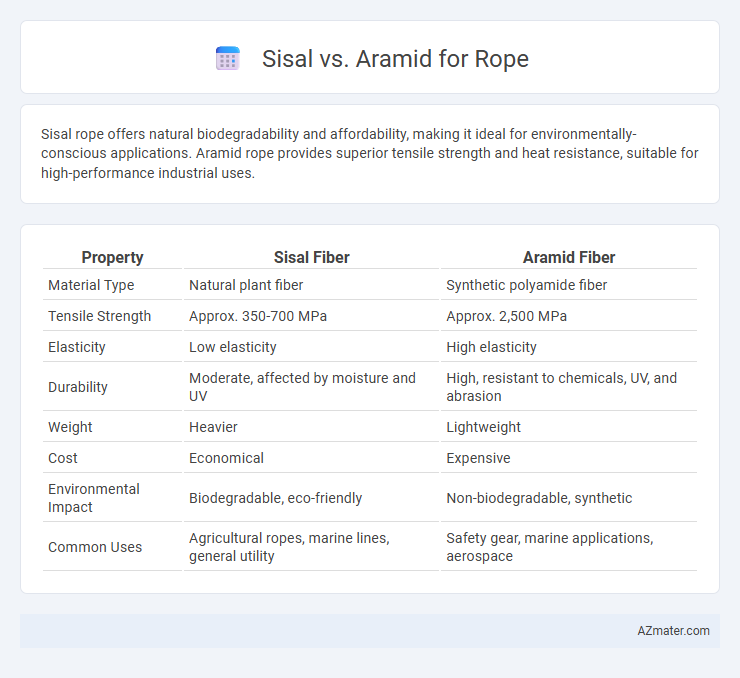Sisal rope offers natural biodegradability and affordability, making it ideal for environmentally-conscious applications. Aramid rope provides superior tensile strength and heat resistance, suitable for high-performance industrial uses.
Table of Comparison
| Property | Sisal Fiber | Aramid Fiber |
|---|---|---|
| Material Type | Natural plant fiber | Synthetic polyamide fiber |
| Tensile Strength | Approx. 350-700 MPa | Approx. 2,500 MPa |
| Elasticity | Low elasticity | High elasticity |
| Durability | Moderate, affected by moisture and UV | High, resistant to chemicals, UV, and abrasion |
| Weight | Heavier | Lightweight |
| Cost | Economical | Expensive |
| Environmental Impact | Biodegradable, eco-friendly | Non-biodegradable, synthetic |
| Common Uses | Agricultural ropes, marine lines, general utility | Safety gear, marine applications, aerospace |
Introduction to Sisal and Aramid Ropes
Sisal rope, made from natural fibers extracted from the Agave sisalana plant, offers excellent biodegradability and resistance to abrasion, making it ideal for environmentally conscious applications. Aramid rope, composed of synthetic fibers such as Kevlar or Twaron, provides superior strength, heat resistance, and durability for industrial and safety-critical uses. Both materials serve distinct purposes: sisal excels in eco-friendly and decorative contexts, while aramid dominates in high-performance and demanding environments.
Material Composition and Properties
Sisal rope, derived from natural agave fibers, offers high tensile strength, biodegradability, and excellent resistance to abrasion and sunlight, making it ideal for eco-friendly applications. Aramid rope, composed of synthetic aromatic polyamide fibers like Kevlar, provides superior heat resistance, exceptional tensile strength, and low stretch, suitable for high-performance industrial and safety uses. The material composition directly influences durability, elasticity, and environmental impact, with aramid excelling in technical demands while sisal suits sustainable and general-purpose needs.
Strength and Load-Bearing Capacity
Aramid fibers, such as Kevlar, offer significantly higher tensile strength and load-bearing capacity compared to natural sisal rope, making them ideal for applications requiring superior durability and resistance to stretching. Sisal rope, while biodegradable and offering moderate strength, typically bears lower loads and has reduced resistance to abrasion and environmental factors. For high-stress industrial or safety-critical uses, aramid rope provides enhanced performance with exceptional strength-to-weight ratios.
Durability and Lifespan
Aramid fibers, known for their exceptional tensile strength and resistance to abrasion, outperform sisal in durability and lifespan, making them ideal for heavy-duty rope applications. Sisal ropes, derived from natural fibers, degrade faster due to environmental factors such as moisture and UV exposure, limiting their longevity compared to synthetic aramid ropes. The advanced chemical stability of aramid ensures superior performance in demanding conditions, extending rope service life significantly beyond that of sisal.
Environmental Resistance: Water, UV, and Chemicals
Sisal ropes exhibit moderate resistance to water but degrade quickly when exposed to prolonged moisture, ultraviolet (UV) rays, and chemicals, making them less suitable for harsh environmental conditions. Aramid ropes, such as Kevlar, provide exceptional resistance to UV radiation, water absorption, and a wide range of chemicals, maintaining strength and durability in marine, industrial, and outdoor applications. The inherent chemical stability and hydrophobic properties of aramid fibers ensure superior longevity compared to natural sisal fibers under environmental stressors.
Flexibility and Handling Characteristics
Sisal ropes offer superior flexibility and natural softness, making them easier to handle and knot compared to Aramid ropes, which tend to be stiffer due to their synthetic fiber composition. Aramid ropes provide high tensile strength and abrasion resistance but may sacrifice some ease of handling and flexibility essential for tasks requiring frequent knotting or manipulation. Choosing between sisal and aramid ropes depends on prioritizing natural pliability for comfort or advanced durability for heavy-duty applications.
Weight Comparison: Sisal vs Aramid
Sisal rope typically weighs more than aramid rope due to its natural fiber composition, resulting in a denser material. Aramid fibers, such as Kevlar, offer a significantly higher strength-to-weight ratio, making aramid ropes much lighter and more efficient for applications requiring reduced weight. This difference in weight impacts handling, load capacity, and ease of use in industrial, marine, and climbing contexts.
Cost Efficiency and Value
Sisal ropes are generally more cost-efficient due to their natural fibers and lower production expenses, making them ideal for budget-conscious applications requiring moderate strength. Aramid ropes, such as Kevlar, offer superior strength-to-weight ratios and high durability, justifying their higher price for critical uses demanding long-term value and resistance to abrasion and heat. Evaluating total lifecycle costs highlights that aramid ropes provide better value in high-performance scenarios despite their initial premium cost.
Eco-Friendliness and Sustainability
Sisal rope is derived from the agave plant, making it biodegradable, renewable, and compostable, which significantly reduces environmental impact compared to synthetic fibers. Aramid rope, while offering superior strength and durability, is petroleum-based and non-biodegradable, contributing to microplastic pollution and higher carbon emissions during production. Prioritizing eco-friendly applications, sisal is preferred for sustainable industries, while aramid is chosen where performance outweighs environmental concerns.
Best Applications for Sisal and Aramid Ropes
Sisal ropes excel in gardening, agriculture, and marine uses due to their natural fiber composition, biodegradability, and resistance to UV rays and abrasion. Aramid ropes, known for their exceptional strength, heat resistance, and lightweight properties, are ideal for high-performance applications such as aerospace, military, and industrial safety equipment. Choosing between sisal and aramid ropes depends on whether eco-friendliness and cost-effectiveness or durability and advanced strength are the primary requirements.

Infographic: Sisal vs Aramid for Rope
 azmater.com
azmater.com